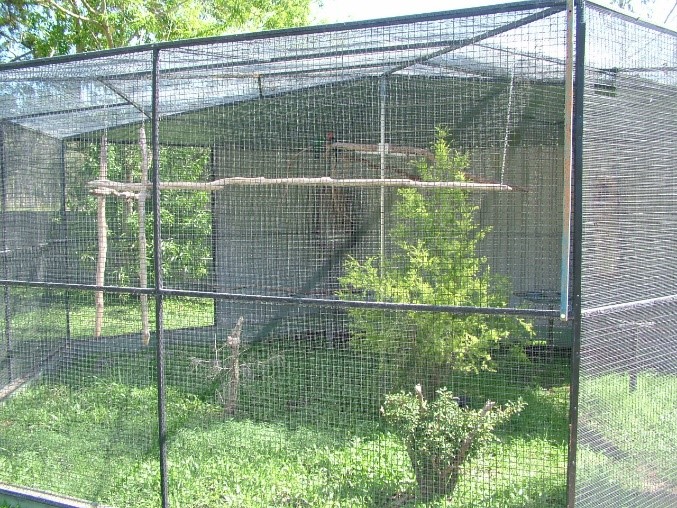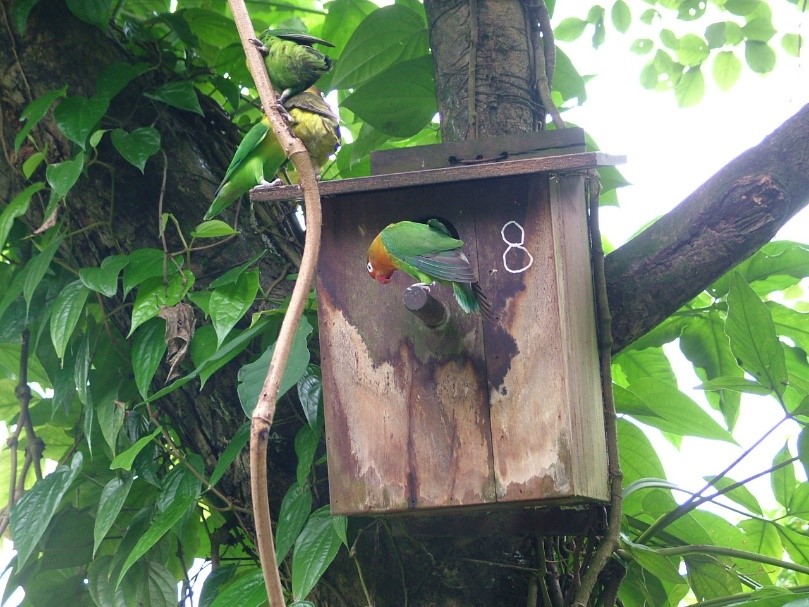Birds have been kept as companion animals (pets) for many hundreds of years, but the last 50 years have seen a surge in their popularity. A large number of species are kept as pets, with interactions ranging from a bird who becomes a part of the household to a bird who, unfortunately, rarely leaves their cage. They all share a common feature in that their living arrangements nearly always involve life in a cage for all or part of their day. Obviously, these cages have a direct effect on the health and welfare of the occupant.
While a cage can provide a safe refuge and home environment for pet birds, most cages are too small to allow birds to fly freely. If your bird never leaves their cage, this severe restriction of the bird’s ability to exercise and express normal behaviour will lead to poor welfare as a result of health problems (obesity, arthritis, soft bones) and mental problems associated with boredom (feather damaging behaviour, screaming, aggression, stereotypy). For these reasons, your birds should have access to a flight aviary or be given regular opportunities to fly in a safe indoor environment outside their cage.
How large should the enclosure be?
While the size of the cage must obviously reflect the size of the bird it houses, it must also reflect the bird’s lifestyle. You should provide a cage as large as possible for your birds, given your financial considerations and available space. A bird who is allowed free range of the household, spending only a small amount of time in the cage each day, can do well in a smaller cage than a similar-sized bird that spends most its time in the cage.
As a rule, the minimum size of the cage should be large enough so that the bird can stretch their wings out without touching the sides and sit on a perch without the tail touching the floor of the cage. If the bird has restricted out-of-cage time, the cage must be large enough for the bird to engage in normal behaviours such as grooming, playing, and moving. Most birds will do better in a cage that is longer, rather than high, as they fly or hop in a horizontal direction rather than vertical.
Not only must the cage hold your birds, but it must also be large enough to contain multiple food and water sources, perches, and toys for enrichment. The following guidelines will help you to work out the minimum size of the home cage environment you should have for your pet birds:
- Width: The minimum width of a cage for a pair of birds should be three times their combined wingspan (the wing span being the length from the tip of one wing to the tip of the other wing, when both wings are stretched out).
- Length: The minimum length of a cage should permit at least two wing beats (the more the better) between perches, allowing your bird to fly horizontally. Perches should be placed far enough from the ends of the cage to allow the birds to turn around on the perches without scraping their tail feathers against the cage.
- Height: The minimum height of a cage should be three times the length from head to tip of tail of the largest bird to be confined in it and should be increased accordingly if more than one pair or more than one species is kept in the cage.
There should be sufficient room for the bird to fully extend his/her wings and to fly without damaging wings or feathers on the walls or ceiling of the cage. Although these are the recommended minimum size, wherever possible even larger enclosures should be provided.
What should it be made of?
The cage should be constructed from material that is strong enough to withstand the power of the bird’s beak; is easy to clean; and is non-toxic if ingested. Plastic-coated wire is commonly used for small bird cages while powder-coated bars, or even stainless steel, are used for larger cages.
There are several requirements for aviary wire: it must be strong enough to withstand chewing by the species in the enclosure; it must be small enough to prevent wild birds entering the enclosure; it must be rust proof, but not so heavily or poorly galvanised that the zinc poses a toxic threat to the birds; and it should be ‘see through’ (this can be achieved by painting the wire black – the silver colour of wire reflects light back into the eyes of the viewer). Small gauge wire, e.g., chicken wire netting, is easily chewed and ingested by large parrots, resulting in heavy metal poisoning, and should be avoided.
This table reflects the size of wire you should consider when purchasing an enclosure or aviary.
| Bird size | Mesh aperture (mm) | Wire thickness (mm) |
|---|---|---|
| Small (20-80g) | 12 x 12 | 0.7-0.8 |
| Medium (80–200g) | 12-25 x 12 | 1.24 |
| Medium - Large (200-500g) | 12-25 x 12 | 1.6 - 1.8 |
| Large (> 500g) | 25-75 x 25-50 | 1.24 - 2.0 |
Positioning the cage
While pet birds can enjoy interacting with their human companions, they can also become stressed by constant noise and movement, lack of privacy and security, irregular diurnal cycles and the possibility of people and other pets colliding with the cage. Indoor cages should be positioned with these stressors in mind. Some suggestions include: position the cage in a corner of a room, so that at least two approaches to it are secure; keep the cage off main traffic routes through the house, lessening close contact with people and other pets; and having a day cage and a night cage, so that birds can be ‘put to bed’ (rather than been covered) at nightfall.
Unless very large, most cages are placed on a stand so that the bird is able to perch at a height level with a person’s chest. Placing the cage on the floor, with human companions and predators such as dogs and cats looming over the top of the bird may be frightening to the bird. The stand should be strong and stable enough to hold the weight of the cage and bird and should ideally be mobile.
Cage furniture
Cage liner: The floor of cage should be lined with an easily replaced, non-toxic substrate. Newspaper or paper towel are appropriate. Sand, wood shavings, corn cob bedding and crushed nut shells are not suitable cage liners as they can cause problems if ingested and may harbour fungal spores and bacteria. Many cages have a wire floor; this is appropriate so long as it is cleaned regularly to prevent spoilt food and dried faecal material adhering to the wire.
Perches: While giving the birds somewhere to sit, perches should not be so numerous that the bird cannot move freely in the cage. Perches should be positioned so that they do not sit above food and water dishes, so that faecal contamination does not occur. The perches should be destructible and safe to consume, as it is normal for parrots to chew on them and important that they can do this. Using metal pipe to avoid replacing perches is not a sound practice! Cotton fibre perches must be monitored carefully, as gastrointestinal obstructions following ingestion of these fibres can be problem. (If your birds chew at the fibres, remove the perches and replace with non-toxic branches.)

Perches should be irregular in shape and diameter, to exercise the birds’ feet and the diameter should be such that the birds’ nails just meet when gripping the perch. A general guide to perch diameter is that the perch should not be so small that the bird’s nails overlap excessively while perched, and not so large that the bird is defecating on the perch. The perches should be removed and replaced when they are soiled or badly damaged. Natural non-toxic branches usually make the best perches. The provision of a concrete ‘grooming perch’ can assist the bird in keeping their beak clean and blunting of the nails. The practice of covering perches with sandpaper should be discouraged as it can lead to abrasions of the sole of the foot and subsequent infection.
Avoid placing bowls directly under perches, as the birds will quite happily defecate and urinate into their food and water, contaminating it and increasing the risk of disease.
Feed and water bowls: These should be of a material suitable for the species; while plastic dishes are fine for a canary, a cockatoo or macaw will destroy them with ease. Stainless steel, glass, or glazed ceramic bowls are generally suitable for most species. Galvanised water dishes, coated in zinc and often soldered with lead, can be highly toxic to birds and should not be used. Terracotta dishes, although they keep water cool, are both absorbent and difficult to clean. The practice of placing water and feed dishes side by side should be avoided, as many parrots are fond of dunking their food in water, leading to contamination of the water and rapid bacterial overgrowth in the water which can cause the birds to become unwell.
Nest boxes: The provision of nest boxes and other sleeping/privacy shelters in a cage is a contentious subject. While birds need a privacy region in their enclosure – somewhere they feel safe if there is a (real or potential) predator nearby (e.g. a nest box), and some species e.g., conures and small macaws sleep in them, other birds will see it as a stimulus for reproductive behaviour. Each situation may have to be weighed on its own merits but if excessive egg laying becomes a problem, it may be best to remove potential nesting sites.

Toys: Many owners provide their birds with toys to relieve boredom. Some of these toys are suitable for the inquisitive but destructive nature of parrots; others are not. Toys with cotton fibres should be avoided as ingestion of these fibres is a common cause of gastrointestinal obstruction. Cheaply made plastic toys or toys with metallic components are easily destroyed and ingested, and this can cause poisoning or block the gastrointestinal tract. Alternatives include non-toxic seed pods (e.g. pinecones, eucalyptus nuts), natural browse, blocks of soft untreated wood, and small cardboard boxes.
Management
Feeding practices: Birds should be fed at least daily; it is a common practice to fill a feed bowl and leave it until it’s empty. This practice, while labour saving, is misguided; empty seed husks can be mistaken for seed, leaving the bird to starve, and food left for long periods of time becomes contaminated with water and faeces, and attracts insect and mice. Fresh clean water should also be provided every day.
Cleaning: Cleaning of both the cage and the cage furniture needs to be done frequently and regularly – at the least once weekly, and ideally every 1-2 days. Cleaning should be aimed at removing organic material and then, where possible, disinfection should follow with a non-irritant chemical. The cage liner should be completely replaced at least twice weekly, more often if heavily soiled or damaged.
References
1. Doneley B (2018) Avian Medicine and Surgery in Practice: Companion and Aviary Birds, 2nd ed. CRC Press
